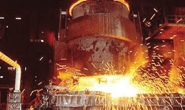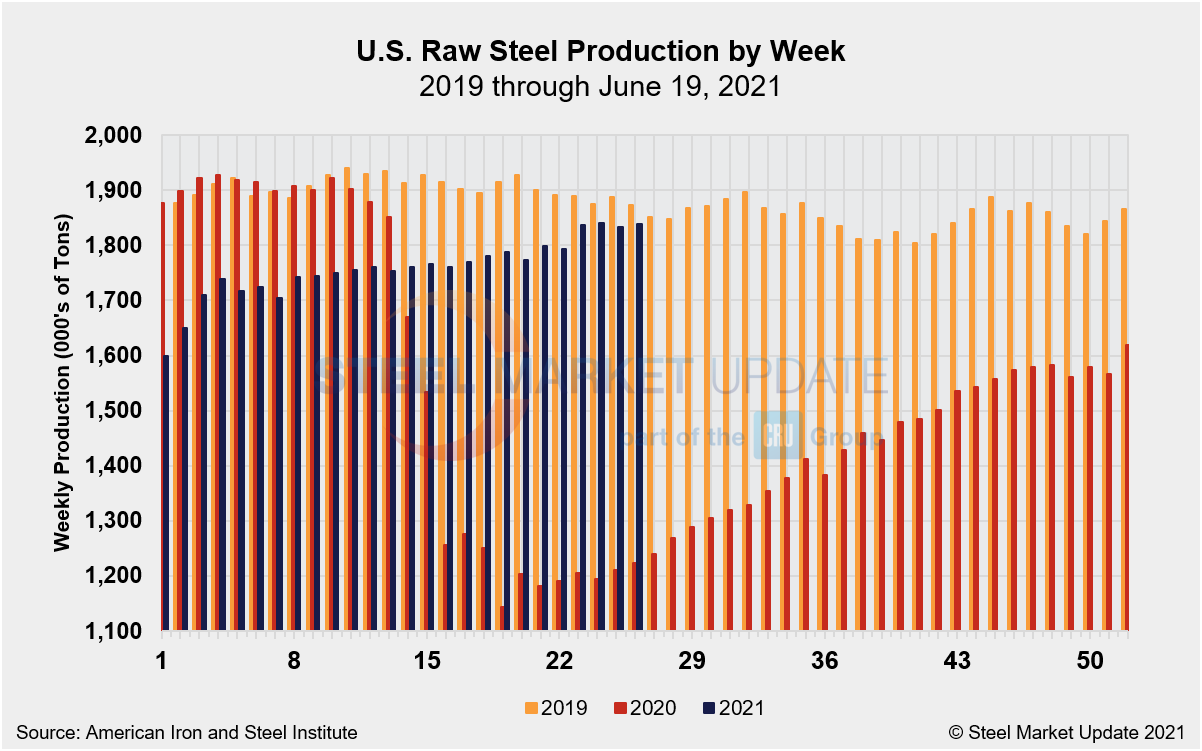Steel Products Prices North America

Weekly Raw Steel Production, Mill Utilization Up 0.3%
Written by David Schollaert
June 22, 2021
Raw steel production by U.S. mills totaled 1,839,000 net tons in the week ended June 19, up 0.3% compared with the week prior when production was 1,834,000 net tons. The average mill utilization rate was 82.9%, also up 0.3% week on week, reported the American Iron and Steel Institute (AISI). Last week’s output represents a 44.6% increase from year-ago levels, when production was just 1,272,000 net tons and utilization was a meager 56.8% as steel mills coped with coronavirus-related interruptions.
The latest data from AISI indicates that annual steelmaking production capacity was downgraded again. The estimated annual capacity has decreased by 2.4% over the past four weeks, from 118.1 million tons to 115.3 million tons. The correction is in line with the associations’ ongoing review of its statistical process. Further changes are likely as permanently idled capacity is accounted for, while soon-to-be new capacity is introduced.

Although mill utilization is back in line with pre-pandemic levels and rising—recently eclipsing the 80.0% mark for the first time since the week ended March 14, 2020—adjustments to production capacity have brought output down by 4.9% when compared to February 2020 levels.
Adjusted year-to-date production through June 19 was 43,219,000 net tons, at an average utilization rate of 78.7%. That’s up 14.2% from the same period last year when the utilization rate was 67.8% and production was 37,837,000 net tons, AISI said.
Following is production by district for the June 19 week: North East, 151,000 net tons; Great Lakes, 634,000 net tons; Midwest, 194,000 net tons; South, 783,000 net tons; and West, 77,000 net tons, for a total of 1,839,000 net tons. Production was up 5,000 net tons compared to the week prior. The decreased output in the Midwest and South districts week on week was offset by increased output in the North East, Great Lakes, and West districts.
Note: The raw steel production tonnage provided in this report is estimated. The figures are compiled from weekly production tonnage provided by approximately 50% of the domestic production capacity combined with the most recent monthly production data for the remainder. Therefore, this report should be used primarily to assess production trends. The AISI production report “AIS 7,” published monthly and available by subscription, provides a more detailed summary of steel production based on data supplied by companies representing 75% of U.S. production capacity. Given the large number of changes to steelmaking capability in the current rapidly evolving market environment, AISI is undertaking a comprehensive review of its raw steel production and capability utilization statistics to ensure that they accurately reflect market conditions. Any updates to capability will be phased in over several weeks. Capability for the second quarter 2021 is approximately 29.3 million tons.
By David Schollaert, David@SteelMarketUpdate.com

David Schollaert
Read more from David SchollaertLatest in Steel Products Prices North America

CRU: Q3 will be the lowest point in current sheet price cycle
CRU Principal Analyst Shankhadeep Mukherjee expects a restocking cycle for steel sheet products in most parts of the world due to either low inventories or seasonally stronger demand.

CRU: US rebar and wire rod prices rise alongside S232 increase
CRU Senior Steel Analyst Alexandra Anderson discusses current market and pricing dynamics for long steel products in the US.

SMU Price Ranges: Sheet and plate steady ahead of Independence Day
Sheet and plate prices were little changed in the shortened week ahead of Independence Day, according to SMU’s latest check of the market.

Nucor maintains plate prices, opens August order book
Nucor aims to keep plate prices flat again with the opening of its August order book.

Nucor CSP remains level at $900/ton
Nucor maintained its weekly list price for hot-rolled (HR) coil this week, following two consecutive increases.
